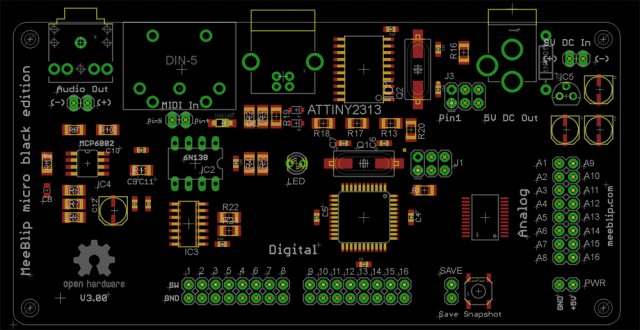MeeBlip creators James Grahame and Peter Kirn have introduced the MeeBlip Micro Black – a new DIY version of their open-hardware synthesizer.
Here’s what’s new in the MeeBlip Micro Black:
- A compact, surface-mount design.
- A USB port. MeeBlip micro still has standard DIN MIDI connections, but it adds USB. That means:
- MIDI over USB. You can now connect to a computer without the need for a separate interface. (Class-compliant support means the iPad works, too, via a Camera Connection Kit.)
- Easier programmability, over USB. The USB port also works for modifying MeeBlip micro’s firmware, so you can hack your micro or use firmware updates – no more need for an additional hardware adapter.
- Knobbier than ever. 16:1 multiplexing now lets you add more knobs – you can have one for each parameter and still have knobs left over. It offers direct switch inputs, too.
- No more lost patches. A snapshot save button writes the current patch to memory so that it’s saved when you turn off MeeBlip. You can change the default MIDI receive channel with that button, too.
The MeeBlip Micro Black is expected to be available in May, with a fully assembled board priced at $49.95/49.95 Euro.


Getting one!!!!
Surface mount is “easier”??
From their site:
“New to micro Black, though, micro is fully assembled.,Pre-assembling actually doesn’t cost much more over providing a kit. And because it’s assembled before it ships to you, we can ensure you’re getting a high-quality, working MeeBlip.
Kits, by contrast, we can’t fully test, which translates into support challenges for us. Instead of reproducing the board we’ve already designed, you can then spend your energy soldering and building something new around the micro board. And given what we’ve seen from you so far, we think that’ll be very interesting.”
Apart from the fact that you get a fully-assembled synth you can play – and then start attaching knobs and sensors and whatever you like – the main thing about “easier” is really USB. Programming the board previously required an additional piece of hardware, and we didn’t have MIDI over USB for computers. Now you can plug into a computer or iPad (via Camera Connection Kit) for MIDI without an adapter, and crucially to making hacking easier, you can program the boards directly over USB. A lot of my summer will be documenting some of those possibilities and the kinds of projects you can build.
Peter
Thanks for taking the time to address reader questions – that makes a huge difference to readers.
“with a fully assembled board priced at..”
how could one not get one at that price?
Am I right in thinking this is just a software based synth with an 8bit DAC?
If so, I can’t see why you’d want one of these over something like a monotron.
Not quite. Meeblip’s output uses two weighted 8-bit DAC channels to approximate a 16-bit DAC. Eight bit resolution is too low for smooth digital envelopes.
Why? It’s a digital instrument that sounds different:
http://soundcloud.com/salatious/eliath-pire
http://soundcloud.com/uem-1/on-the-edge
Thanks for addressing the reader questions, James! It means a lot to people.
Because you can do much more with this one: you can program and play complex sounds and not only the beeps that Monotron does; you can control this thing with MIDI and USB and you can integrate it into a larger project.
What I would like to see is a tiny synth like this I can stack in a box and have at least 16 knobs on top to control it with. Also, I want it to be drone-only, with no keyboard. Can this, or any other MeeBlip, do this? I currently run Skrewell in Reeaktor with a custom knob controller, but I want to get rid of the laptop part if possible.
One of my early Meeblip prototypes was set up as a multi-oscillator drone synth. I used it for standalone waveform and filter testing, but never really gave much thought about polishing it up for release.
This seems like exactly what you need if you don’t mind putting together the box and controls you want. The possibilities on these synths are pretty vast, especially for the size/price.
So it just droned by itself when you turned it on? I’d be interested in something like that… If you thought anyone else would be interested in Drones like that. I know there’s not a lot of us.
Exactly. It had no envelopes, so it always made sound. It needed some clever LFO modulation routing. Or maybe even a joystick to mix oscillators.
Maybe a way to just turn the envelopes off…
providing a ready built PCB is a great idea! The really fun part is the hacking and case making anyway!
Its a shame there isnt a kit version of this… or any other Meeblip anymore.. i know it isnt cost effective but for me it looses part of the fun.
We thought what people were doing *with* the boards was even more fun – there’s still plenty of making to be had, only now rather than recreating the working board, people are making their own controls and housings and sensors and adding control voltage and all this other stuff. And it wasn’t just cost effectiveness – see our explanation; it really means that otherwise we can’t be sure of the quality of what we’re shipping and we spend time only on support.